By the end of this comprehensive lesson about Asteroids, Meteors, and Comets, students will be able to describe the physical properties, locations, and movements of meteors, asteroids, and comets. Each of our lessons is designed using the 5E method of instruction to ensure maximum comprehension by the students. This well-thought out unit does the heavy lifting, giving teachers easy-to-implement, highly engaging lesson plans.
This blog will walk you through each of the steps and activities from the Asteroids, Meteors, and Comets 5E Lesson Plan.
ENGAGEMENT
At the beginning of the lesson, the class will discuss the objectives and some of the relevant vocabulary using the included objective statements and word wall cards.
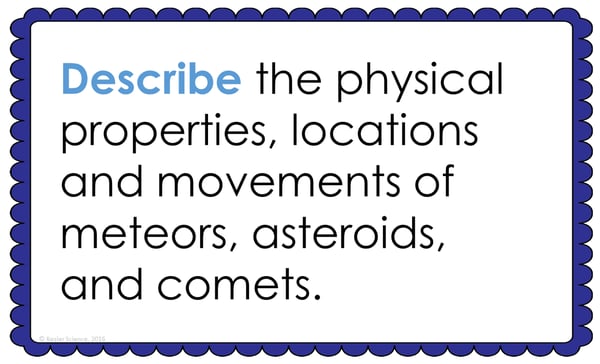
The engagement activity continues with a with a Think-Pair-Share activity to list the characteristics or differences between asteroids, meteors, and comets. The teacher will help to clear any misconceptions like meteors and comets are the same things.
Estimated Class Time for the Engagement: 20-30 minutes
EXPLORATION
This student-centered station lab is set up so students can begin to explore just what asteroids, meteors, and comets are. With nine stations in total, you can introduce asteroids, meteors, and comets to your middle school students in a variety of ways! Four of these stations are considered input stations where students will learn new information about asteroids, meteors, and comets; and four of the stations are output stations where students will be demonstrating their mastery of the lesson's material. A bonus station offers challenges for your early finishers and independent learners. You can read more about how I set up the station labs here.
Watch It!
At this station, students will be watching a very quick two minute video describing the differences between asteroids, meteors, and comets. Students will then answer some questions relating to the video and record their answers on their lab station sheet.
Read It!
This station will provide students with a one-page reading about asteroids, meteors, and comets. Students are asked four questions about the reading, alternate titles, vocabulary, fill in the blanks, and parts of comets.
Explore It!
Students will be working in pairs to create a model of the locations of asteroids, meteors, and comets within the solar system. Students will use different yarn colors to represent both asteroids and comets. Students will sketch the orbit of both asteroids and comets as they revolve around the Sun.
Research It!
The research station will allow students to get online and interact with a lesson about comets, and asteroids. Students can click on different tabs informing them and showing the important information about each concept.
Organize It!
The Organize It station allows your students to use a manipulative to match information provided to either asteroids, meteors, and comets.
Illustrate It!
Your visual students will love this station. Students will be illustrating asteroids, meteors, and comets. Also the parts of a comet, and size difference between and meteor and asteroid.
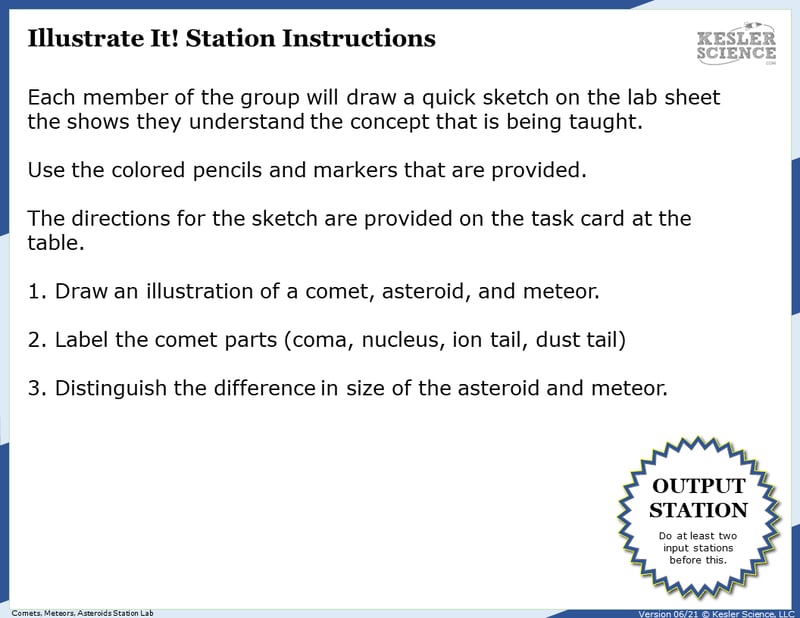
Write It!
Students who can answer open-ended questions about the lab truly understand the concepts that are being taught. At this station the students will be answering three questions like describe the differences between asteroids, meteors, and comets, comparing orbits, and the three differences between meteors, meteoroid, and meteorites.
Assess It!
The Assess It station is where students will go to prove mastery over the concepts they learned in the lab. The questions are setup in a standardized format with multiple choice answers. Some questions will ask students to compare a meteor to meteorites, the composition of comets, origins of comets and asteroids, etcetera.
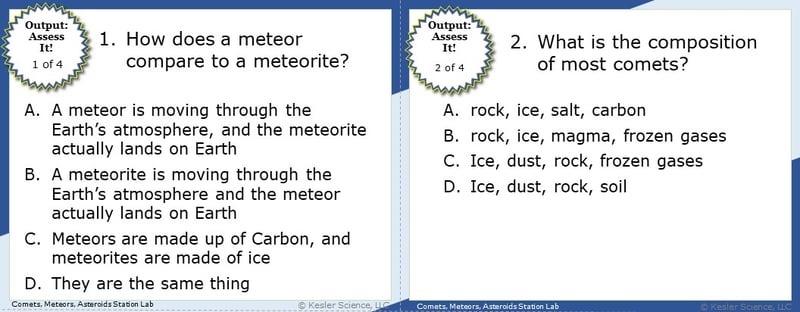
Challenge It! - Bonus Station
Early finishers and advanced students will love the extension activities in this station. Expand their learning through crosswords, games, and mini projects.
Estimated Class Time for the Exploration: One or two 45-minute class periods
EXPLANATION
The explanation activities will become much more engaging for the class once they have completed the exploration station lab. During the explanation piece of the lesson, the teacher will be clearing up any misconceptions their students may have about asteroids, meteors, or comets with a variety of materials. These materials include on-level and modified versions of the interactive presentation (may be used individually or projected), anchor charts, and paper or digital interactive notebook activities. If you have students that need modified notes, the 5E lessons come equipped to help give every student access to the lesson.
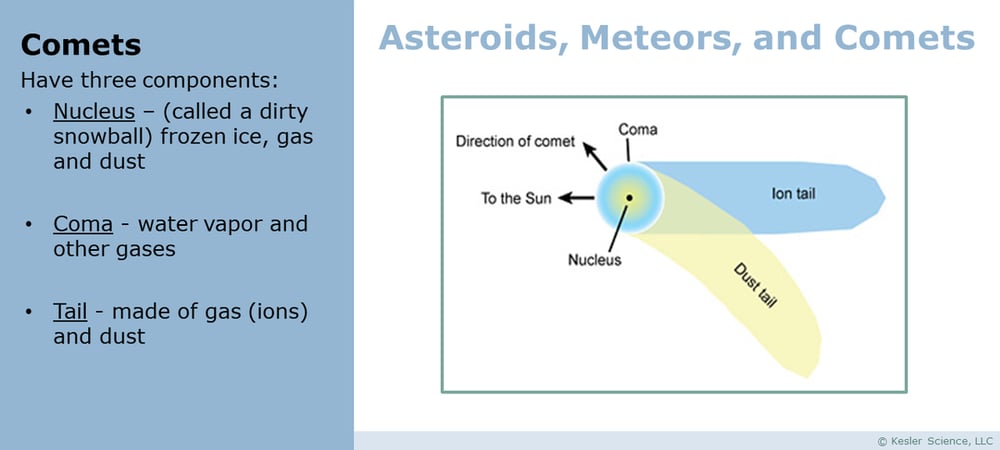
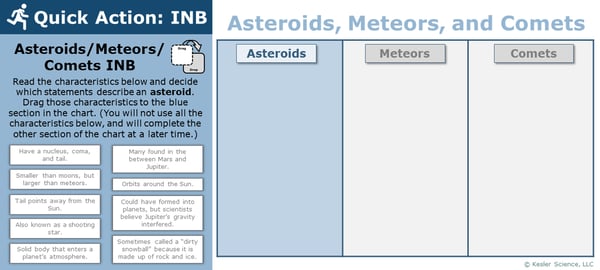

Interactive notebook samples: Above-left is a digital INB activity slide; above-right is an example of the paper INB activities.
The students will also be interacting with their journals using INB templates for asteroids, meteors, and comets. Each INB activity is designed to help students compartmentalize information for a greater understanding of the concept. The asteroids, meteors, and comets INB templates will challenge the students to understand and visualize the differences between all three.
Estimated Class Time for the Exploration: Two or three 45-minute class periods
ELABORATION
The elaboration section of the 5E method of instruction gives students choices that allow them to prove they’ve mastered the concepts behind a lesson. When students are given a choice, they’re much more enthusiastic and invested in the project than they are when their teachers choose their projects for them. There are a total of nine choices to demonstrate understanding of asteroids, meteors, and comets. A separate set of choices that offer more teacher support are also available for students that need them. Rubrics guide students to doing their best work and assist in grading.

Estimated Class Time for the Elaboration: Two or three 45-minute class periods (can also be used as an at-home project)
EVALUATION
The final piece of the 5E model is an evaluation of your students' comprehension of the material. Included in every 5E lesson is a homework assignment, assessment, and modified assessment. Research has shown that homework needs to be meaningful and applicable to real-world activities in order to be effective. When possible, I like to give open-ended assessments to truly gauge the student’s comprehension.
Estimated Class Time for the Elaboration: One 45-minute class period.
DOWNLOAD THE FULL LESSON NOW
Download Over $100 in FREE Resources
For Middle School Science
Simply create a login below and gain immediate access to a selection of our Kesler Science product line worth $100 - for FREE. There's a full version of every product type! You'll also join tens of thousands of middle school science teachers who receive timely tips and strategies straight to their inbox.







